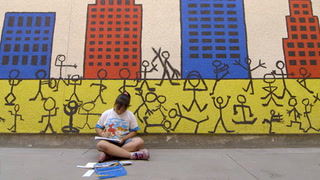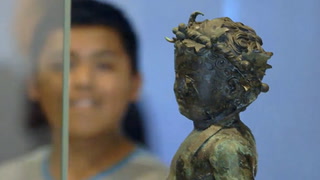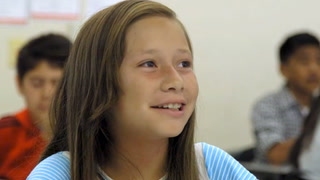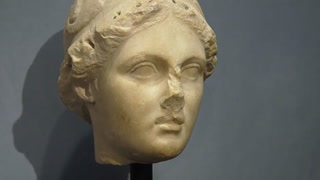The Power of Arts Integration: Series Overview Transcript
ELIZABETH ESCAMILLA
00:00:03 The arts are for everyone and art just captivates the students and it opens up a world of learning and experience. Part of our mission as a museum is to ensure that as many students as possible have access to our collection.
00:00:22 And so, our approach is to work closely with teachers to develop arts-integrated lessons across the curriculum.
00:00:30 [TITLE: The Power of Arts Integration: A Video Series Overview]
ELIZABETH ESCAMILLA
00:00:34 At the Getty Museum, the Education Department is committed to providing high quality resources and professional development to teachers across the country.
SANDY RODRIGUEZ [sync]
00:00:44 We have a resource that is online, really focused on ELL strategies, using our still life as the primary source.
ELIZABETH ESCAMILLA
00:00:52 The idea is to build relevant, sustainable content that other teachers can be inspired by and use in their classroom.
VERONICA ALVAREZ
00:01:01 We really wanted to teach the teach the teachers about arts integration. What we’re hoping is the teachers will take ownership and kind of change their teaching practice and do arts-integrated lessons in the classroom.
ELIZABETH ESCAMILLA
00:01:13 Classroom teachers across the country have different resources available to them, but the digital world has opened up a whole new set of resources to teachers. We have over 200 lessons available on Getty.edu for free for teachers.
00:01:26 [TITLE: Search Lesson & Activities on www.getty.edu]
ELIZABETH ESCAMILLA
00:01:28 Now Common Core aligned in terms of standards, as well as national and state standards - lessons and resources that have been created either by classroom teachers themselves or alongside museum educators and artists.
ANTOINETTE PIPPEN
00:01:42 My name is Antoinette Pippen. I am a 5th grade teacher at the Alexander Science Center School.
ANTOINETTE PIPPEN [sync]
00:01:48 Looking at this work of art, would you say that it is balanced or imbalanced?
ANTOINETTE PIPPEN
00:01:54 In class I engage my students in a discussion about the health of an ecosystem based on an observation of an art piece. And through that exploration, we can delve deeper into the science standards.
ANTOINETTE PIPPEN [sync]
00:02:08 Do you think that it’s a balanced ecosystem?
GIRL WITH SIDE BRAID
00:02:11 No. There’s not enough biodiversity for it to be a healthy ecosystem.
ANTOINETTE PIPPEN
00:02:18 The students are getting a lot more science and scientific thinking through studying art. It frees them to think about things from different perspectives and it allows them to understand that there’s no right or wrong answer, necessarily.
00:02:32 But there’s better justified answers. There’s more evidence for particular answers. And that’s really the same in art and science. And there’s so much available to you online. I was able to download high-resolution images through the Getty website. There is an extensive database of different works of art just at your fingertips.
00:02:52 [TITLE: Search Lesson & Activities on www.getty.edu]
ELIZABETH ESCAMILLA
00:02:55 Most teachers have access to a museum. Even if it’s a small, regional art museum. Our goal is to provide lessons where the content can be transferred to a different set of objects in a local collection. So, perhaps teachers use our collection in their classroom, but then make a really valuable and rich connection in their community.
00:03:19 And what our resources hopefully do is inspire teachers to do just that.
DAVID COOPER [sync]
00:03:24 Now I’d like to focus on the identification of who is this a statue of and why.
DAVID COOPER
00:03:30 I teach 6th grade Social Studies. This unit focuses on Greek and Roman mythology, so this lesson is going to help them when they see these Greek and Roman gods in art form, either at a museum or in an image in front of them. But it’s also going to help them understand why the Greeks included these mythological figures in their art and their culture.
STUDENT IN BLACK & WHITE STRIPES
00:03:51 Well, we think it’s a statue of Artemis because Artemis always has a short tunic. And if you look at her shoes closely, there’s like a crescent moon.
DAVID COOPER
00:03:59 If they’re identifying those attributes in actual art objects it hooks them in ways I haven’t found anything else does.
ELIZABETH ESCAMILLA
00:04:08 To have the strongest collaboration with teachers we need to be sensitive to the challenges that impact their profession. And Common Core is one. So, we’re sharing in the same challenges that they are and we’re trying to collectively figure out how to do it. We’re learning alongside them.
SANDY RODRIGUEZ [sync]
00:04:26 Congratulations. You guys did such an incredible job at really thoughtfully planning out the lesson steps for a pretty complex project.
LORENZA ARENGO-YARNES
00:04:34 My name is Lorenza Arengo-Yarnes and I am a 5th grade elementary school teacher. With the Language Arts lesson the students are creating the art piece and then writing an opinion piece about it.
00:04:48 The Common Core element is citing evidence. When we think about the Common Core, these standards are not just isolated to reading and writing and to science or in math. It’s also connected in the arts. Being able to look at a piece of art and if you’re going to have an opinion about that piece of art, what is your evidence for that.
00:05:09 I believe in the arts because I- I think that having that Common Core connection really enhanced all of their learning.
VERONICA ALVAREZ
00:05:16 When the Common Core came out I know some teachers were a little bit like, “Oh my gosh,” but I was really excited about it actually because when I started reading a lot of the standards, I was like this is what we’ve been doing in museum education for so long.
00:05:28 In Common Core you’re reading texts closely and making inferences, so that’s what looking at a painting is. We’re closely reading the painting, just looking and making inferences directly from what we see.
LINDSAY YOUNG
00:05:41 My name is Lindsay Young and I teach 9th through 12th grade English Language Development. My students are not only in mild to moderate special education, but they’re also long-term English language learners. In this lesson, the goal was that they make literal observations and evidence-based inferences.
00:06:01 It’s just so important with English language learners to have a visual representation of what I’m asking them to do.
LINDSAY YOUNG [sync]
00:06:08 Today we’re going to read portraits like we would read a story. So, things I can point to – the children are wearing white dresses. It looks like silk or satin.
LINDSAY YOUNG
00:06:21 So, you have a student. They have a really challenging time with reading. And then you’re trying to get them to do this critical analysis, which is also challenging. So, the thought process is look at art, teach them how to analyze, then they’ll know how to analyze so then you can have them look at a text. And now the challenging thing is no longer the analysis because they know how to do that.
00:06:44 Now, the only challenging thing that we’re dealing with is reading.
LINDSAY YOUNG [sync]
00:06:47 Can anybody wear silk or satin?
JOSE
No, just upper class people.
YANDIRA
00:06:51 When they’re like rich.
LINDSAY YOUNG [sync]
00:06:53 Rich. Exactly. You guys are expert inference makers.
ELIZABETH ESCAMILLA
00:06:58 I think people underestimate the impact engaging with works of art has on people, kids in particular. Because they’re so open in terms of everything they take in. They are the future ambassadors for the arts.
AMANDA YATES-GARCIA [sync]
00:07:14 That’s looking great. It’s very expressive.
AMANDA YATES-GARCIA
00:07:17 I’m Amanda Yates-Garcia and I’m a teaching artist. And I’m working with the 5th grade teachers here at the school in collaboration with the Getty Museum. One of the great things about schools working with museums, kids can go and really be inspired by what they’re seeing.
00:07:32 In art there is science, literature, history, and culture. So, it’s just a really great alliance uniting all of those different things in this project-based, immersive way where kids feel a sense of ownership and authority over what they’re doing.
ELIZABETH ESCAMILLA
00:07:49 Most of us when we see a work of art, we have a visceral reaction. We love it. Or, you know, it doesn’t move us. But when something moves us, it makes us want to learn more.
00:08:02 These objects, they have a life. And these objects live on when they are talked about and written about and inspiring people to create something. And that we’re entrusting teachers to do everyday.
00:08:29 ***FILE END***
















11 Comments
Paula Pleasant Dec 22, 2020 1:18pm
Paula Pleasant
I love this!! I am planning to use this resource in my room, it will help my Kinder students in several common core areas especially ELAR ( reading, language ) Visuals always help to engage students and just the exposure to art and museums is in itself a new experience. Some students will never or have until this point never been to a museum . It will spark creativity hopefully, I have some Kinders with no imagination at all, they don't aren't use to using their imaginations . I am so excited about this resource!! Thanks
Michael Stires Jun 22, 2020 1:18pm
The goal of arts integration is to increase knowledge of a general subject area while developing a greater understanding and appreciation of the fine and performing arts. Students engage in a creative process which connects an art form and another subject and meets evolving objectives in both. Students engage in critical thinking and construct personal meaning through their learning in arts-integrated lessons. They develop the skills to work through problem-solving and to innovate new solutions. This builds grit and perseverance capacities in all learners. The Getty Museum has great resources for teachers from the collecting ideas for core lessons, to incorporating the museum website to be used to cite supporting evidence. The students will be able to visualize the topics and be able to learn about their differences with the help of the Getty Website sources.
Alexander Thompson Mar 16, 2020 11:36pm
1. How can arts integration increase student engagement?
Arts integration can increase student engagement by taking a topic that a student has already studied in class and understanding it in a different perspective. symbols, patterns, cultural behaviors and scientific discoveries are just a few examples of works of art that you can find in a museum that you can discover more about that you are learning at school with your peers and teachers.
2. What can you learn about integrating the arts in your classroom?
Students and teachers can learn about periods of history through integrating the arts in your classroom. Characters in history or even transformative moments during a war can help portray more of what happened that sometimes text cannot achieve.
3. How do the teachers use resources from the Getty Museum?
Teachers can use the resources from the Getty Museum through collections or individual common core lessons. Teachers can print our or display the content and images of art that exist in real museums. The artist information can be cited and the classroom is able to find the evidence all from the Getty Museum website where the students can learn, create and analyze the works. Students can spot visual differences in the topics they learn in the classroom with the help of the Getty Sources.
La Tonya Young Mar 10, 2019 10:34pm
The integration of Arts into the classroom allows for students who may not be strong in regular content, the opportunity to excel. It also gives the teacher the foundation for linking deeper contexutal understanding with the academic standards. Students who are struggling to process certain vocabulary or concepts within the curriculum may be able to forge links with its integration. The processing of thouhg the Arts requires allows for critical thinking to happen.
Mary Bartz Mar 10, 2019 7:07pm
Very interesting museum website that i plan to check out. If they see it and learn about artist and techniques used they can create their own and make their own inferrences about it.